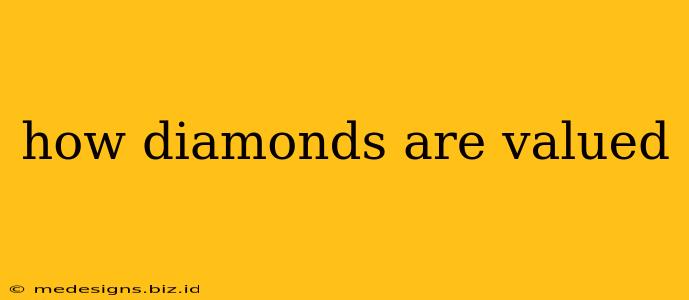Diamonds. Words that conjure images of sparkle, luxury, and enduring love. But beyond the romantic allure lies a complex system of valuation that determines a diamond's price. Understanding this system empowers you to make informed decisions when purchasing or selling this precious gemstone. This comprehensive guide delves into the intricacies of diamond valuation, going beyond the familiar 4Cs.
The Four Cs: The Foundation of Diamond Grading
The four Cs – Cut, Clarity, Carat, and Color – form the cornerstone of diamond grading. They represent the key characteristics that significantly influence a diamond's value. Let's explore each one in detail:
1. Cut: More Than Just Shape
While the shape (round, princess, emerald, etc.) is part of the cut grade, it's the proportion, symmetry, and polish that truly define it. An expertly cut diamond maximizes brilliance, fire, and scintillation – the dazzling light play that makes diamonds so captivating. Poorly cut diamonds, even if they boast high carat weight and clarity, will appear dull and lifeless. A superior cut grade translates to a higher value.
2. Clarity: Internal and External Flaws
Clarity refers to the presence or absence of inclusions (internal flaws) and blemishes (external flaws) within a diamond. Flawless diamonds are incredibly rare and command the highest prices. However, many inclusions and blemishes are microscopic and invisible to the naked eye, impacting value less dramatically. The grading scale considers both the number and nature of these imperfections.
3. Carat: Weight Matters
A carat represents the weight of a diamond, with one carat equaling 200 milligrams. Larger diamonds are generally more valuable, but the value increase isn't linear. A one-carat diamond doesn't cost double a half-carat diamond of similar quality. The jump in price becomes more pronounced as carat weight increases.
4. Color: The Absence of Color
Most diamonds possess a hint of color, ranging from colorless (D) to light yellow or brown. Colorless diamonds are highly sought after and therefore more expensive. The GIA (Gemological Institute of America) color grading scale uses letters to represent the color grade, with D being the most colorless and Z the most colored.
Beyond the 4Cs: Factors Influencing Diamond Value
While the 4Cs provide a fundamental framework, other factors also impact a diamond's price:
-
Fluorescence: The ability of a diamond to glow under UV light. While some fluorescence can enhance a diamond's appearance, strong fluorescence can sometimes slightly affect its value.
-
Certification: A reputable grading report from a recognized gemological laboratory, such as GIA or AGS, adds significant credibility and transparency to a diamond's value. These reports act as a third-party verification of the 4Cs.
-
Brand Reputation: The reputation and brand of the retailer can also influence price, particularly for designer diamonds.
-
Market Demand: Current market trends and overall demand can fluctuate diamond prices. Certain shapes and cuts may be more in vogue at any given time.
-
Shape and Style: Certain diamond shapes, like round brilliant cuts, are more popular and consequently, more valuable than others. Unique cuts or fancy shapes can also command premium prices.
Making Informed Decisions
Understanding how diamonds are valued is crucial for any buyer or seller. By familiarizing yourself with the 4Cs and the additional factors discussed above, you can navigate the diamond market with confidence and make informed choices that align with your budget and preferences. Remember to always obtain a reputable grading report and consider seeking professional advice from a qualified gemologist before making a significant purchase.
